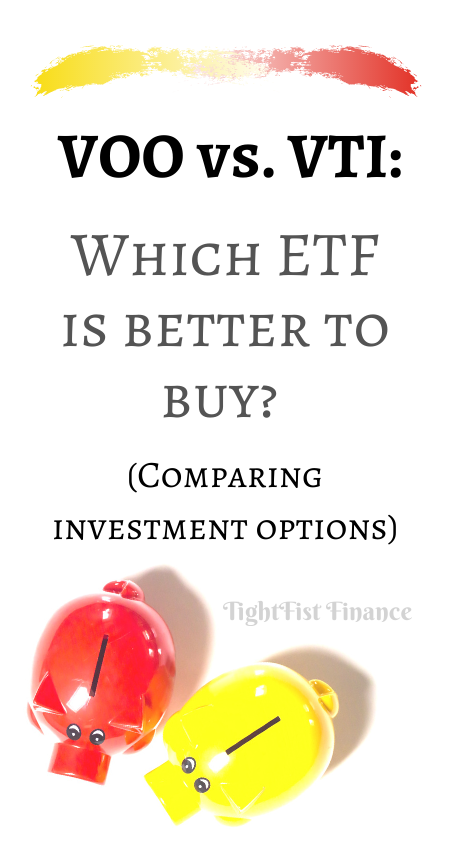VOO Vs. VTI: Which Vanguard ETF is better to buy?
Both VTI and VOO are good ETFs to purchase. VOO is an S&P 500 index which tracks the top 500 stocks in the U.S. VTI is the total stock market fund, which contains all of VOO plus extra stocks. VTI is weighted based on market cap, which means the top 500 stocks hold significant weight in the funds performance.
Imagine, owning one of the best exchange traded funds available. Your investments tend to rise over time, leaving you to sit back and watch your money grow.
Luckily for you, I’m going to show you the similarities and differences of VOO vs. VTI. At the end of this article, you’ll have a good understanding of each ETF.

This article may contain affiliate links which pays a commission and supports this blog. Thank you for your support!
VOO vs. VTI: What is the difference?
The primary difference between VOO and VTI is the number of holdings (stocks within the fund). VOO currently has 508 holdings with the top 500 U.S. stocks, while VTI has 3,566. VTI contains VOO’s holdings and is weighted based on market-cap. Therefore, VOO’s holdings hold a significant weight in VTI – so the ETFs may perform similarly.
VOO seeks to track the S&P 500, or the top 500 U.S. stocks. The top 500 stocks tend to drive overall market performance. Since VTI tracks overall market performance, both ETFs tend to perform similarly.
Simply stated, when you buy VTI you’re buying VOO plus extra stocks. But the way the funds are structured, the VOO stocks drive the majority of performance.
Here’s a table which shows the top 10 holdings for VOO and VTI. You’ll notice, all but one stock is the same.
| # | VOO Top Holdings
(29.10% of total net assets) as of 09/30/2020 |
VTI Top Holdings
(24.00% of total net assets) as of 09/30/2020 |
| 1 | Apple Inc. | Apple Inc. |
| 2 | Microsoft Corp. | Microsoft Corp. |
| 3 | Amazon.com Inc. | Amazon.com Inc. |
| 4 | Alphabet Inc. | Alphabet Inc. |
| 5 | Facebook Inc. | Facebook Inc. |
| 6 | Berkshire Hathaway Inc. | Berkshire Hathaway Inc. |
| 7 | Johnson & Johnson | Johnson & Johnson |
| 8 | Procter & Gamble Co. | Procter & Gamble Co. |
| 9 | Visa Inc. | Visa Inc. |
| 10 | NVIDIA Corp. | Tesla Inc. |
Currently, both funds have a 0.03% expense ratio. Therefore, buying VOO over VTI will not cost you any extra. Vanguard’s fees are the same.
Both funds also pay a quarterly dividend. VOO currently pays a 1.63% yield while VTI pays a 1.5% yield. Essentially, there’s no substantial difference in dividend yield.
Click to Tweet! Please Share!Click To TweetPerformance history of VOO vs. VTI
Both VTI and VOO perform similarly, largely due to the weighting of individual stocks. VOO has performed slightly better with a 10 year annualized return of 13.70%. VTI has a 10 year annualized return of 13.48%. Therefore, investing in either funds will yield similar performance.
So why did VOO slightly outperform VTI? VOO only tracks the top 500 stocks and VTI has a significant weight in VOO stocks. However, VTI also contains an additional 3,000 stocks which may not have performed as well.
The additional 3,000 stocks in VTI don’t have a significant weight, so they don’t drive performance. However, they were enough to make a 0.22% difference.
Over the last 10 years, investing $10,00 in VTI would yield $33,340.22. The same investment in VOO would yield $33,866.90. A difference of $526.68.
Therefore, it doesn’t matter which fund you invest in because performance is similar. VTI will provide a slightly higher level of diversification, but both funds are well diversified.
Is VOO better than VTI?
VOO is marginally better than VTI. The performance history for the 10 year annualized return is only a 0.22% difference. VTI is heavily influenced by the VOO holdings, so either ETF will provide similar returns.
Both funds have a significant level of diversification. However, if you’re wanting the largest level of diversification possible, then choose VTI. If you’re ok with holding 500 stocks for diversification, choose VOO for the slight increase in performance.
Personally, I invest in VTI because of the extra level of diversification. Honestly, I would be fine investing in an S&P 500 index fund like VOO. In the end, the details are too small to worry about.
My recommendation is to pick and stick with one or the other. Either way, the funds are majorly controlled by the same companies.
Click to Tweet! Please Share!Click To TweetSummary: VOO vs. VTI: Which ETF is better to buy?
As you can see, both ETFs are good for long term investing. VOO holds a slight performance advantage, while VTI is more diversified. When you buy VTI, you are also buying the stocks contained in VOO. Both funds are well diversified.
The primary difference between VOO and VTI is the number of holdings. VOO holds 508 of the biggest U.S. stocks and seeks to track the S&P 500. VTI holds 3,566 different stocks, but the majority of the performance comes from the VOO holdings.
Performance between VTI and VOO is similar. Annualized 10 year returns are 13.48% for VTI and 13.7% for VOO. Both funds have a similar expense ratio and dividend yield.
My personal opinion is that both ETFs are a good choice. Choose VTI if you’re looking for more diversification.